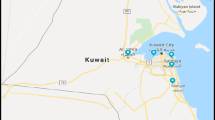Abstract
We analyzed 137Cs in aerosols, rock, soil and river suspended sediment collected after the Fukushima Daiichi Nuclear Power Plant (FDNPP) accident. Based on the results, we discuss the post-event behavior and transportation of radiocesium in the environment from the air into ground and river systems. First, radionuclides were emitted from the FDNPP as airborne ‘hot’ particles, which contained water-soluble fractions of radiocesium. Radiocesium was still present in a water-soluble fraction after deposition on the ground. Subsequent interaction of the ‘hot’ particles with water (e.g. rainfall) dissolved and strongly fixed the radiocesium on rock and soil particles, thus changing the radiocesium into insoluble forms. The distribution of ‘hot spots’ was possibly controlled by the initial position of deposition on the ground. Consequently, ‘hot spots’ were studded on the rock surface rather than being uniformly distributed. The distribution of radiocesium in river suspended particles was not homogeneous during water transportation, reflecting the heterogeneity of radiocesium in rock and soil. Leaching experiments demonstrated that radiocesium in rock, soil and river suspended sediment was fairly insoluble, showing that the adsorption reaction is irreversible. The micro-scale heterogeneous distribution of radiocesium in aerosols, soil and suspended particles was due to the presence of ‘hot’ particles in aerosols. Dissolution of radiocesium in the ‘hot’ particles in the aerosols and subsequent irreversible adsorption onto the soil particle complex are responsible for the preservation of the heterogeneity both in soil and in river suspended particles.








Similar content being viewed by others
References
Nuclear Emergency Response Headquarters Government of Japan (2011) http://www.kantei.go.jp/foreign/kan/topics/201106/iaea_houkokusho_e.html. Accessed 6 July 2012
Chino M, Nakayama H, Nagai H, Terada H, Katata G, Yamazawa H (2011) J Nucl Sci Technol 48:1129–1134
Endo S, Kimura S, Takatsuji T, Nanasawa K, Imanaka T, Shizuma K (2012) J Environ Radioact 111:18–27
Cardis E, Kesminiene A, Ivanov V, Malakhova I, Shibata Y, Khrouch V et al (2005) J Natl Cancer Inst 97:724–732
Kato H, Onda Y, Teramage M (2012) J Environ Radioact 111:59–64
Ohno T, Muramatsu Y, Miura Y, Oda K, Inagawa N, Ogawa H, Yamazaki A, Toyama C, Sato M (2012) Geochem J 46:287–295
Tanaka K, Takahashi Y, Sakaguchi A, Umeo M, Hayakawa S, Tanida H, Saito T, Kanai Y (2012) Geochem J 46:73–76
Santschi PH, Bollhalder S, Farrenkothen K, Lueck A, Zlngg S, Sturm M (1988) Environ Sci Technol 22:510–516
Owens PN, Walling DE (1996) Appl Radiat Isot 47:699–707
Sutherland RA (1996) Hydrol Process 10:43–53
Kaste JM, Heimasath AM, Hohmann M (2006) Geomorphology 76:430–440
Schaub M, Konz N, Meusburger K, Alewell C (2010) J Environ Radioact 101:369–376
Phillips JM, Russell MA, Walling DE (2000) Hydrol Process 14:2589–2602
Evans DW, Alberts JJ, Clark RA III (1983) Geochim Cosmochim Acta 47:1041–1049
Vidal M, Roig M, Rigol A, Llauradό M, Rauret G, Wauters J, Elsen A, Cremers A (1995) Analyst 120:1785–1791
Kanai Y (2012) J Environ Radioact 111:33–37
Bostick BC, Vairavamurthy MA, Karthikeyan KG, Chorover J (2002) Environ Sci Technol 36:2670–2676
Qin H, Yokoyama Y, Fan Q, Iwatani H, Tanaka K, Sakaguchi A, Kanai Y, Zhu J, Takahashi Y (2012) Geochem J 46:297–302
Ministry of Education, Culture, Sports, Science and Technology, Japan (MEXT) (2011) http://radioactivity.mext.go.jp/en/. Accessed 6 July 2012
Kinoshita N, Sueki K, Sasa K, Kitagawa J, Ikarashi S, Nishimura T, Wong Y, Satou Y, Handa K, Takahashi T, Sato M, Yamagata T (2011) PNAS 108:19526–19529
Sandalls FJ, Segal MG, Victorova N (1993) J Environ Radioact 18:5–22
Yoschenko VI, Kashparov VA, Protsak VP, Tschiersch J (2003) Appl Radiat Isot 58:95–102
Bondietti EA, Brantley JN, Rangarajan C (1988) J Environ Radioact 6:99–120
Hilton J, Cambray RS, Green N (1992) J Environ Radioact 15:103–111
Tomášek M, Rybáček K, Wilhemová L (1995) J Radioanal Nucl Chem 201:409–416
Jost DT, Gaggeler HW, Baltensperger U, Zinder B, Haller P (1986) Nature 324:22–23
Seinfeld JH, Pandis SN (2006) Atmospheric chemistry and physics: from air pollution to climate change, 2nd edn. Wiley, New York
Hsu CN, Wei YY, Chuang JT, Tseng CL, Yang JY, Ke CH, Cheng HP, Teng SP (2002) Radiochim Acta 90:659–664
Lee CP, Lan PL, Jan YL, Wei YY, Teng SP, Hsu CN (2006) Radiochim Acta 94:679–682
He Q, Walling DE (1996) J Environ Radioact 30:117–137
Cremers A, Elsen A, De Preter P, Maes A (1988) Nature 335:247–249
Mckinley JP, Zeissler CJ, Zachara JM, Serne RJ, Lindstrom RM, Schaef HT, Orr RD (2001) Environ Sci Technol 35:3433–3441
Yoshida N, Takahashi Y (2012) Elements 8:201–206
O’Day PA, Rehr JJ, Zabinsky SI, Brown GE (1994) J Am Chem Soc 116:2938–2949
Sakaguchi A, Chiga H, Iwatani H, Tanaka K, Takahashi Y (in preparation)
Acknowledgments
The authors thank Y. Watanabe, A. Kadokura and M. Fujiwara for their help in the experiments. The aerosol filter samples were kindly provided by Kawasaki Municipal Research Institute for Environmental Protection. The EXAFS measurement has been performed with approvals of KEK (Proposal No. 2011G644 and 2011G197) and JASRI (Proposal No. 2011B1569). This work has been done in the FMWSE project (Fukushima Radiation Monitoring of Water, Soil and Entrainment) supported by MEXT (Ministry of Education, Culture, Sports, Science & Technology in Japan).
Author information
Authors and Affiliations
Corresponding author
Rights and permissions
About this article
Cite this article
Tanaka, K., Sakaguchi, A., Kanai, Y. et al. Heterogeneous distribution of radiocesium in aerosols, soil and particulate matters emitted by the Fukushima Daiichi Nuclear Power Plant accident: retention of micro-scale heterogeneity during the migration of radiocesium from the air into ground and river systems. J Radioanal Nucl Chem 295, 1927–1937 (2013). https://doi.org/10.1007/s10967-012-2160-9
Received:
Published:
Issue Date:
DOI: https://doi.org/10.1007/s10967-012-2160-9




